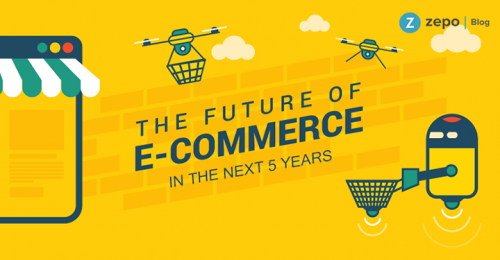E-commerce India | Industry Overview, Market Size & Growth
There is a low penetration of E-commerce in India as compared to the markets of the United States (266 million userbases, 84%) or France (54 million userba
- by aditi verma 2020-01-30 06:22:10
The Internet user base of India is more than 475 million. This is approximately 40 percent of the population. By the end of 2019, this figure reached 627 million. India has the second-largest internet user base in the world, after China. E-commerce has completely changed the way business is done in India.
Most of the growth of E-commerce in India got triggered by the rise in the internet and smartphone penetration. Other reasons include the launch of the 4G networks and an increase in consumer wealth.

There is a low penetration of E-commerce in India as compared to the markets of the United States (266 million userbases, 84%) or France (54 million userbases, 81%). But, it is gradually growing with the addition of about 6 million new users each month. The growth of the e-commerce industry is at an inflection point.
E-commerce in India or electronic commerce is the activity of buying or selling of goods or online services through the Internet.
Electronic commerce works on technologies including mobile commerce, electronic funds transfer, supply chain management, Internet marketing, online transaction processing, electronic data interchange (EDI), inventory management systems, and automated data collection systems.
The Cash on delivery mode of payment is the most preferred payment method in India which accumulates around 75 percent of the e-retail activities. There is a fast-growing demand for international consumer products (also long-tail items) than the supply of the in-country products from various authorized distributors and e-commerce websites.
In the year 2017, the largest e-commerce companies in India included Flipkart, Amazon, Myntra, Paytm, and Snapdeal. While in the year 2018, Amazon had been recorded as the biggest e-commerce in India in the revenue terms and beat Flipkart.
The e-commerce sector in India has witnessed an amazing level of growth and it is expected to grow even more. There are also many e-commerce ventures that have faced a lot of pressure for ensuring the cash flows. There are many e-commerce websites that have flourished but at the same time many of them did not work out. These include Dhingana, IndiaPlaza.in, eBay-India, Rock.in, Seventy MM and others who had to close down. Some of them also had to bring a change to their business models so as to survive in a competitive environment.
Due to the spread of e-commerce, there has been an increase in the niche players who specialize in their products for a specific theme. Every day, around 1,06,086 websites are registered online and over 25 percent of these are for the niche businesses.
Also Read: eBikeGO gets $300K for expanding its electric two-wheeler fleet
During the year 2014, Royal Enfield had sold about 200 bikes of its special series on their Online platform. One of the most popular businesses is online apparel as well as computers and consumer electronics. Together they make up 42 percent of the total retail e-commerce sales.
The e-commerce industry in India has been impacting the micro, small & medium enterprises (MSME) in a direct way as it provides a means for the financing, technology, and training and has had a favorable effect on the other relevant industries too. The e-commerce industry in India has seen an upward growth trajectory and it is expected that India may surpass the US becoming the second largest e-commerce market in the world by the year 2034.
The various technology-enabled innovations including digital payments, hyper-local logistics, analytics-driven customer engagement, and digital advertisements are most likely going to support the growth of e-commerce in India. With the enormous growth in the e-commerce sector in India, these will be a boost in employment, an increase in the revenues from export, increase in the tax collection by the ex-chequers, and availability of better products and services to the customers.
Picture Source: Zepo
Also Read: E-commerce News India | eBikeGo| Two Wheeler Rental| To expand Fleet
POPULAR POSTS
Loan EMIs to Drop as RBI Slashes Repo Rate - Full MPC December 2025 Highlights
by Shan, 2025-12-05 11:49:44
Zoho Mail vs Gmail (2025): Which Email Platform Is Best for Businesses, Startups, and Students?
by Shan, 2025-10-09 12:17:26
PM Modi Launches GST Bachat Utsav: Lower Taxes, More Savings for Every Indian Household
by Shan, 2025-09-24 12:20:59
$100K H-1B Visa Fee Explained: Trump’s New Rule, Clarifications & Impact on Indian Tech Workers
by Shan, 2025-09-22 10:11:03
India-US Trade Deal Soon? Chief US Negotiator Arrives in Delhi as Talks Set to Begin Tomorrow
by Shan, 2025-09-15 11:54:28
Modi Meets Xi: Trump’s Tariffs, Strategic Autonomy, and the Future of Asia’s Power Balance
by Shan, 2025-09-03 06:40:06
Google Claims Gemini AI Uses Just ‘Five Drops of Water’ Per Prompt, Sparks Debate
by Shan, 2025-08-22 12:34:27
RECENTLY PUBLISHED

Pine Labs IPO 2025: Listing Date, Grey Market Premium, and Expert Outlook
- by Shan, 2025-11-05 09:57:07

The Agentic Revolution: Why Salesforce Is Betting Its Future on AI Agents
- by Shan, 2025-11-05 10:29:23

Top 10 Insurance Companies in India 2026: Life, Health, and General Insurance Leaders Explained
- by Shan, 2025-10-30 10:06:42

OpenAI Offers ChatGPT Go Free in India: What’s Behind This Big AI Giveaway?
- by Shan, 2025-10-28 12:19:11

Best Silver Investment Platforms for 2025: From CFDs to Digital Vaults Explained
- by Shan, 2025-10-23 12:22:46





 Subscribe now
Subscribe now 